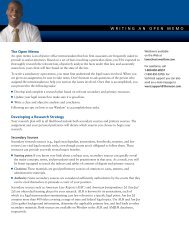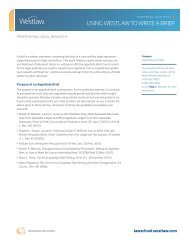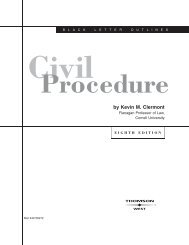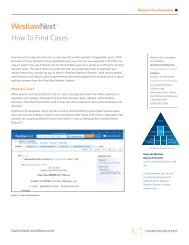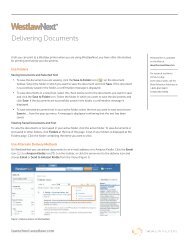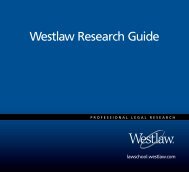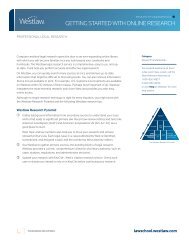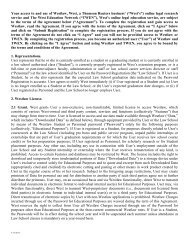Winning Research Skills - Westlaw
Winning Research Skills - Westlaw
Winning Research Skills - Westlaw
You also want an ePaper? Increase the reach of your titles
YUMPU automatically turns print PDFs into web optimized ePapers that Google loves.
Chapter 4<br />
within agencies, and calendars of meetings. Final regulations are published chronologically. The<br />
Federal Register also publishes some documents issued by the office of the president, such as<br />
presidential proclamations and executive orders.<br />
The Federal Register may fill as many as 50,000 pages a year. Because it occupies a huge amount<br />
of shelf space—despite the small size of its typography—you will easily be able to locate it in the<br />
law library. If you plan on pursuing a career in a heavily regulated practice area, you’ll do well<br />
to familiarize yourself with using the Federal Register while you are a student.<br />
Documents from the Federal Register beginning with January 1981 are available on <strong>Westlaw</strong> in<br />
the Federal Register 1981–Current database (FR). Documents from the Federal Register from<br />
January 1936 to December 1980 are available in the Federal Register Archive (1936–1980)<br />
database (FR-OLD).<br />
Code of Federal Regulations<br />
Adopted regulations are first published chronologically in the Federal Register and subsequently<br />
arranged by subject in the Code of Federal Regulations (CFR). Proposed regulations do not<br />
appear in the CFR. The entire CFR is recompiled annually—new regulations are added, changes<br />
to existing regulations are incorporated, and regulations that have been withdrawn are deleted.<br />
The CFR is organized by title. Each title represents a broad subject. Therefore, when you need to<br />
find federal regulations by subject, look to the CFR.<br />
Each title of the CFR is divided into chapters; each chapter is devoted to the regulations of a<br />
particular agency. The chapters are further divided into parts, consisting of a set of regulations<br />
pertaining to a particular topic or agency function. Parts are divided into sections (the basic unit<br />
of the CFR), and if further breakdown is necessary, into paragraphs.<br />
Two sets of notes provide administrative history information for a regulation (Figure 4.1).<br />
■ The authority note prefaces each part of the CFR. The authority note indicates the statutory<br />
authority under which the regulations are proposed or issued. Remember that regulations are<br />
adopted to implement legislation.<br />
■ A source note, which lists the volume, page, and date of the Federal Register in which the<br />
regulation was published, follows the authority note.<br />
The CFR is published each year in four installments as follows:<br />
■ Title 1 through Title 16—through January 1<br />
■ Title 17 through Title 27—through April 1<br />
■ Title 28 through Title 41—through July 1<br />
■ Title 42 through Title 50—through October 1<br />
Because of these staggered dates, you must be careful to check the softbound cover of each title<br />
to determine the date of revision.<br />
All 50 titles constituting the current CFR are available on <strong>Westlaw</strong> in the Code of Federal<br />
Regulations database (CFR).<br />
42 <strong>Winning</strong> <strong>Research</strong> <strong>Skills</strong>



